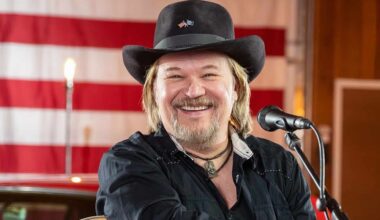In April 1969, Bob Dylan released Nashville Skyline—a soft-spoken, country-tinged album that felt like it had fallen from a different planet compared to the rebellious, cryptic masterpieces that preceded it. Gone was the snarling voice of Highway 61 Revisited. Gone were the surreal lyrics of Blonde on Blonde. In their place: a warm croon, twangy guitars, and straightforward love songs. For many fans and critics, the question was immediate: What happened to Bob Dylan?
Nashville Skyline didn’t just mark a change in sound—it marked a transformation of persona. Dylan’s famously nasal voice was suddenly smooth and mellow. His political edge was dulled, replaced with romanticism and a kind of pastoral calm. And instead of pushing sonic boundaries, he embraced the clean, classic stylings of Nashville’s best studio musicians. It was jarring. It was confusing. But, in its own quiet way, it was brilliant.
The story of Nashville Skyline begins in the aftermath of Dylan’s motorcycle crash in 1966. After the whirlwind years of protest anthems, electric controversy, and drug-fueled recording sessions, Dylan retreated into a quieter life in Woodstock, New York. He recorded basement demos with The Band, became a father, and largely disappeared from the public eye. By the time John Wesley Harding arrived in 1967—a sparse, biblical, folk-blues album—it was clear Dylan was changing. But no one expected what came next.
In early 1969, Dylan returned to Columbia’s Nashville studios with producer Bob Johnston and a group of local musicians, including Charlie Daniels and Pete Drake. He also reconnected with country icon Johnny Cash, with whom he recorded a series of loose, heartfelt duets—one of which, “Girl from the North Country,” opened the new album. The chemistry between Cash and Dylan was real, and their track set the tone for what followed: a record of sincerity, simplicity, and unexpected sweetness.
Perhaps the most striking aspect of Nashville Skyline was Dylan’s voice. It wasn’t a studio trick. It wasn’t falsetto. It was Dylan, deliberately singing in a gentle, rounded tone he’d never used before. When asked about it, he simply said, “I quit smoking.” Whether that’s fully true or not remains debated, but the effect was profound. Songs like “I Threw It All Away” and “Lay Lady Lay” shimmer with a calm vulnerability that felt radically different from his past.
Critics were divided. Some hailed the album as a bold reinvention. Others accused Dylan of abandoning his roots or “selling out” to Nashville’s commercial sensibilities. But time has been kind to Nashville Skyline. Its influence can be heard in the alt-country and Americana movements. Its spirit lives on in artists who blend genres without apology. And its gentle tone now reads less like a departure and more like a necessary breath—a moment of peace between the storms of Dylan’s career.

“Lay Lady Lay,” the album’s breakout hit, climbed the charts and introduced Dylan to a new audience—one that may not have connected with his earlier, more abrasive work. Meanwhile, songs like “To Be Alone with You” and “Tonight I’ll Be Staying Here with You” revealed a warmth and domesticity in Dylan’s writing that felt both new and strangely intimate.
What’s more, Nashville Skyline helped bridge the gap between folk-rock and country music. It showed that Dylan—always a student of American song traditions—could move through musical landscapes without losing his essence. And in doing so, he opened the door for others: The Byrds, Gram Parsons, Emmylou Harris, and later, Wilco and Jason Isbell—all owe something to the trail Dylan quietly blazed.
It’s easy to overlook the boldness of Nashville Skyline in hindsight. There were no controversial lyrics or electric shockwaves this time. But to radically alter your sound at the height of your fame, to lean into softness in an era of noise—that takes a different kind of courage. Dylan wasn’t chasing trends. He was stepping away from them.
Today, the album stands as one of the most fascinating chapters in Dylan’s evolution. It’s the sound of an artist catching his breath, choosing beauty over chaos, clarity over complexity. And in doing so, he reminded the world that reinvention doesn’t always have to be loud.
Nashville Skyline is not Dylan’s most famous work, nor his most critically praised. But it might be his most sincere. It came from a place of peace and gratitude, not rebellion. And perhaps that’s why, more than five decades later, it still feels fresh—not because it shocks, but because it soothes.





